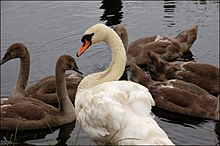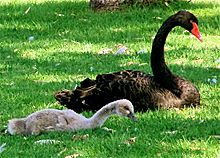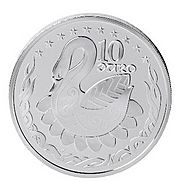Swan facts for kids
Quick facts for kids Swans |
|
|---|---|
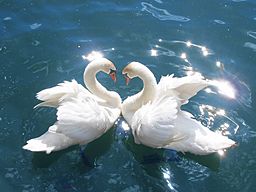 |
|
| Mute Swans (Cygnus olor) | |
| Scientific classification | |
| Kingdom: | |
| Phylum: | |
| Class: | |
| Order: | |
| Family: | |
| Subfamily: |
Anserinae
|
| Genus: |
Cygnus
Bechstein, 1803
|
| Synonyms | |
|
Cygnancer Kretzoi, 1957 |
|
A swan is a type of large water bird. Swans belong to the group of birds called Cygnini, which includes the main types of swans in the Cygnus and Coscoroba groups. They are part of the Anserinae family, which also includes geese and ducks.
A baby swan is called a cygnet.
Many swans live in colder places like northern Europe, Asia, and North America. They live on water and are great swimmers. Swans eat plants from the bottom of ponds, lakes, or even the ocean. They also eat insects and other small animals. Swans are also able to fly.
Contents
What Do Swans Look Like?

Swans are the biggest birds in the waterfowl family called Anatidae. They are also among the largest flying birds on Earth! The biggest types, like the mute swan, trumpeter swan, and whooper swan, can grow to be over 1.5 meters (5 feet) long. They can weigh more than 15 kilograms (33 pounds). Their wings can spread out over 3.1 meters (10 feet) wide!
Compared to their relatives, geese, swans are much larger. They have bigger feet and longer necks. Swans have jagged parts on their bills that look like small teeth. These help them catch and eat plants, insects, and small fish. Adult swans also have a patch of skin without feathers between their eyes and bill. Male and female swans look similar in their feathers, but males are usually bigger and heavier.
Swan Colors
Swans that live in the Northern Hemisphere (the top half of the world) are usually pure white. But swans in the Southern Hemisphere (the bottom half of the world) can be a mix of black and white. For example, the Australian black swan (Cygnus atratus) is almost completely black. It only has white feathers on its wings that you can see when it flies. Baby black swans are light grey. The South American black-necked swan has a white body but a black neck.
Most swans have dark blackish-grey legs. However, the two types of swans from South America have pink legs. The color of their bills (beaks) also changes. The four types of swans from colder, subarctic areas have black bills with some yellow. All other swans have bills that are patterned red and black. The mute swan and black-necked swan have a small bump at the base of their upper bill.
Where Do Swans Live and How Do They Travel?

Swans usually live in places with mild weather, not in very hot tropical areas. A group of swans is called a bevy. When they are flying together, a group is called a wedge.
There are four (or sometimes five) types of swans in the Northern Hemisphere. One type lives in Australia. One type that is now extinct used to live in New Zealand and the Chatham Islands. And one type lives in southern South America. You won't find swans in tropical Asia, Central America, northern South America, or anywhere in Africa. The mute swan is a type that has been brought to North America, Australia, and New Zealand by people.
Many swans are migratory, meaning they travel long distances at certain times of the year. Some swans migrate completely, while others only migrate from certain areas. The mute swan, for example, stays in Western Europe all year. But in Eastern Europe and Asia, mute swans migrate. The whooper swan and tundra swan always migrate. Trumpeter swans almost always migrate. There is some idea that the black-necked swan also migrates, but scientists are still studying how far they travel.
How Do Swans Live?

Swans find their food both in water and on land. They mostly eat plants. However, they might eat small amounts of water animals too. In the water, they often tip their bodies upside down to reach food at the bottom. Their diet includes roots, stems, and leaves of plants that grow in or under the water.
Reproduction and Family Life

Swans are famous for mating for life. This means they usually stay with the same partner forever. They often form a strong pair bond even before they are old enough to have babies. For example, trumpeter swans can live up to 24 years. They only start having babies when they are 4 to 7 years old. But they form their strong pair bonds as early as 20 months old.
Sometimes, a pair of swans might "divorce," but this is rare. One study found that only about 3% of successful breeding pairs split up, and 9% of pairs that didn't have babies split up. Swans stay together all year, even in groups that migrate.
Swan nests are built on the ground near water and are about a meter (3 feet) wide. Unlike many other ducks and geese, the male swan helps build the nest. Both parents also take turns sitting on the eggs to keep them warm. This is unusual for water birds! A mute swan's egg is about 113 by 74 millimeters (4.4 by 2.9 inches) and weighs about 340 grams (12 ounces). Swans usually lay 4 to 7 eggs. The eggs hatch after 34 to 45 days.
Swans are very protective of their nests and their babies. They will fiercely attack anything they think is a danger to their cygnets, even humans.
Swans in Culture and Stories
Many stories and ideas about swans come from the mute swan in Europe. One of the most famous stories is "The Ugly Duckling" fable. Swans are often a symbol of love or loyalty because they stay with their partners for a long time. You can see swans in famous operas like Lohengrin and Parsifal.
Swans in Mythology and Legends
Swans are very important in mythology (ancient stories). In Greek mythology, there's a story about Leda and the Swan. It says that Helen of Troy was born after the god Zeus turned into a swan and met Leda, the Queen of Sparta.
Old stories also say that the mute swan would sing beautifully just before it died. This is where the phrase "swan song" comes from, meaning a final performance or act. The mute swan is also a special bird for the god Apollo. He is often shown riding a chariot pulled by swans.
The Irish legend of the Children of Lir tells about a stepmother who turned her children into swans for 900 years. In another Irish legend, The Wooing of Etain, a king of magical beings turns himself and a beautiful woman into swans to escape from the king of Ireland. A swan has even been shown on an Irish coin.
Swans also appear in Irish poems by W.B. Yeats. His poem "The Wild Swans at Coole" focuses on how amazing swans are. He also wrote a poem about the myth of Leda and the Swan.
In Norse mythology, two swans drink from a special well in Asgard, the home of the gods. The water from this well is so pure that everything it touches turns white, including these swans and all their descendants. Another Norse poem, Volundarkvida, talks about swan maidens.
In the Finnish epic story Kalevala, a swan lives in the river of the underworld. The story says that anyone who killed this swan would also die. Today, five flying swans are a symbol of the Nordic Countries. The whooper swan is the national bird of Finland, and the mute swan is the national bird of Denmark.
Swans in Ballet and Art
The ballet Swan Lake is one of the most famous classical ballets. It uses music by Pyotr Ilyich Tchaikovsky. The main characters, Odette (the white swan) and Odile (the black swan), represent good and evil. These roles are some of the hardest to dance in ballet. Swan Lake is performed by ballet companies all over the world.
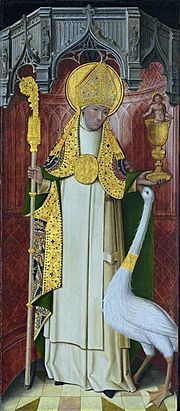
A swan is also linked to St Hugh of Lincoln because of a story about a swan that was very loyal to him.
In Latin American literature, the poet Rubén Darío made the swan a symbol of artistic inspiration. He showed how often swans appear in Western culture. His poem Blasón – "Coat of Arms" (1896) is very famous for this. Because of Darío, the swan became a symbol for the Modernismo poetry movement.
Swans in Hinduism
Swans are highly respected in Hinduism. They are compared to holy people who live in the world but are not attached to it, just like a swan's feather stays dry even in water. The Sanskrit word for swan is hamsa. The "Raja Hamsam" or Royal Swan is the vehicle of Goddess Saraswati, who represents purity and knowledge.
It is believed that if a swan is given a mix of milk and water, it can drink only the milk. Because of this, Goddess Saraswati rides a swan. The swan symbolizes "Viveka," which means being wise and able to tell the difference between good and bad, or between what lasts forever and what is temporary. This is seen as a great quality, as shown in this Sanskrit verse:
|
|
Swans are mentioned many times in ancient Hindu texts called the Vedas. In the Vedas, swans are said to live on Lake Manasarovar in the summer and fly to Indian lakes for the winter. They are believed to have special powers, like being able to eat pearls. People who have reached high spiritual levels are sometimes called Paramahamsa ("Supreme Swan"). This is because of their spiritual wisdom and their ability to travel between different spiritual worlds.
Swans are also closely linked to divine twins in old Indo-European religions. It is thought that in very ancient times, swans were a symbol of the sun and were connected to the divine twins and an early sun goddess.
The Black Swan Theory
The Black Swan theory comes from an old idea in Ancient Rome that black swans didn't exist. So, a "black swan" became a way to describe something that could exist in theory but was never seen. After real black swans were discovered, the phrase changed. Now, a "black swan" is a metaphor for a very unexpected event or outlier that has a huge and unforeseen impact.
See also
 In Spanish: Cisnes para niños
In Spanish: Cisnes para niños


